
views
X
Research source
Determining if a Cat is Actually Choking
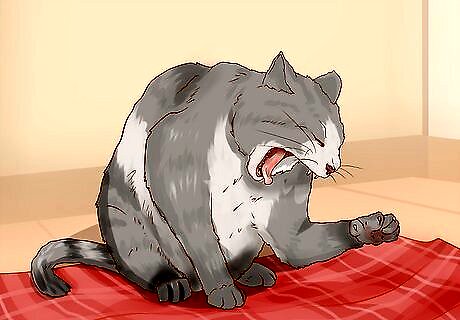
Look for signs of choking. These are important to identify quickly. The signs of a choking cat include: Inability to breathe Coughing forcefully Drooling or gagging Pawing at the mouth
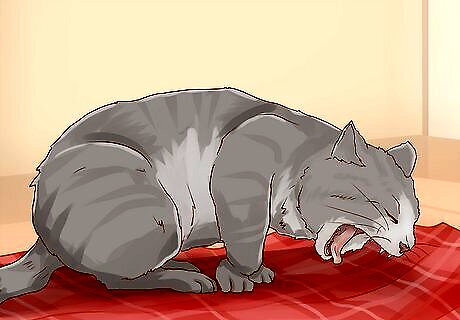
Be aware of signs that mimic choking. These include an exaggerated breathing effort involving the whole body, while at the same time the cat makes a whistling noise as it tries to breathe out. These movements and sounds can be quite dramatic. Cats can make things harder for humans because they're fond of coughing up fur balls or retching up grass, each of which could mislead you into thinking that the cat is choking. In fact, retching is frequently confused with choking by cat owners, as it's a common symptom in cats.

Assess whether it is likely that the cat is actually choking. Ask yourself, "What was the cat doing immediately beforehand?". If the cat was asleep, or quietly walking across a room, and starts making choking noises then it is unlikely it is choking. This is because it didn't pick anything up in its mouth, so it hasn't had access to any thing to get stuck.
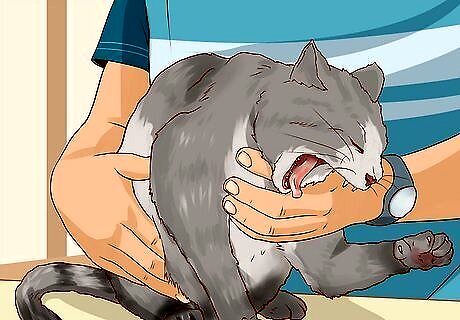
Keep the cat calm during an episode that is only mimicking choking. These episodes can be caused by a cat taking a sudden deep breath and pulling part of the soft palate against the larynx (the entrance to the airway). Then repeated deep breaths keep suctioning the soft palate against the airway. Simply calming the cat and getting it breathing slowly usually does the trick. Speak to the cat gently, try petting its fur, and even stroke it under the chin. Sometimes it helps to get the cat to swallow, which releases suction on the soft palate and allows the anatomy to realign correctly. To get a cat to swallow try offering it a super tasty treat.

Check the color of the cat's gums. If all else fails, you can look at the cats gums to determine if it is getting enough oxygen. Pink gums indicate it is getting plenty of oxygen and is in no immediate danger. Blue-tinged or purple gums indicate a lack of oxygen and an emergency. If the gums are blue or purple contact your vet immediately to warn them you are on the way. If the gums are purple or blue take a quick look inside the cat's mouth. If you can't see the obstruction or easily remove it, then don't waste further time and take your cat straight to the vet. If you can see the obstruction and can remove it easily then you should.
Giving First Aid to a Choking Cat

Deal with the situation immediately. Cats have an extremely sensitive larynx and if it goes into laryngeal spasm, the airway can be shut off completely, asphyxiating the cat. There is no time to be waiting for a vet's assistance. However, call the vet both for advice and to warn them that you will be coming in if possible.

Wrap the cat securely in thick material, such as a towel. Leave only the head exposed. This will support the cat and control its front limbs.

Look in the cat's mouth. Angle the cat's head back slightly to be able to open up her mouth and see better inside. Use one finger to depress the lower jaw. Use tweezers to remove an object that is obvious. If you can't see what is causing the blockage or it's too deeply lodged or wedged in, do not attempt to remove it. Do not stick your fingers into the cat's mouth. Not only could you be bitten but you might cause the choking object to be pushed in further. Having a helper to hold down the cat can be a huge help for you.

Try to expel the obstruction. Use the palm of your hand to thump the cat gently but firmly between the shoulder blades. Alternatively, you can apply several quick, squeezing compressions on both sides of its ribcage. To administer squeezing compressions, do the following: Sit down on the floor with the cat in front of you but facing away from you. Lift the cat's hind legs and hold them between your knees. Place one hand on either side of the cat's chest and squeeze with sufficient firmness to compress the chest by a third. Do not apply excessive force - it may break her ribs. When squeezing, use jerky movements. The aim is to try to get the cat to cough. Squeeze four to five times; this should be enough to get her to cough out the obstruction.
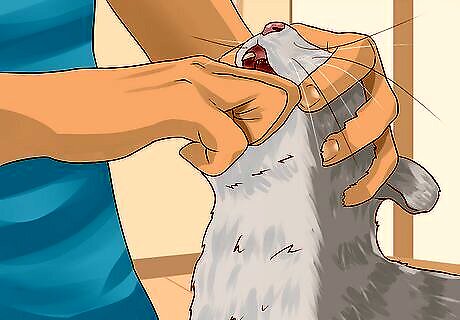
Treat an unconscious cat differently. Your cat may faint or become unconscious in response to the lack of oxygen. If so, do the following: Open up its jaws as wide as possible. There won't be any damage from opening the jaws up wide. Look for an obstruction. If it is easy to see and not wedged in, use tweezers to remove it. In this case, you could use your fingers but only if you're able to avoid putting pressure on the object, as it could wedge it further into the airway. Swab away any fluid using a clean cloth or tissue. Lie the cat on a slope with its head lower than its heart. This is to help any fluid in its mouth drain out, rather than flow back down the throat where the cat might inhale it. Don't use cotton wool or balls, as these can stick to the throat. Once you're certain that the throat and airway are clear, begin rescue breaths on your cat, using mouth-to-nose resuscitation. Applied quickly in the absence of an obstruction, this can save your cat's life.
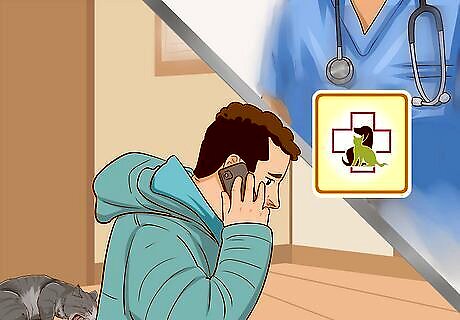
Make an appointment to see the vet quickly if you do manage to remove the obstruction. It is important to have the cat checked out to assess whether the obstruction caused any damage in the cat's throat. Keep it calm until you can get it to the vet.

Get the cat to the vet immediately if you don't manage to dislodge the obstruction. Make sure that the method of transportation is as stress-free as possible (having a helper is vital if possible) and keep a good air supply coming into the car. Call the vet practice to let them know you're on your way.




















Comments
0 comment